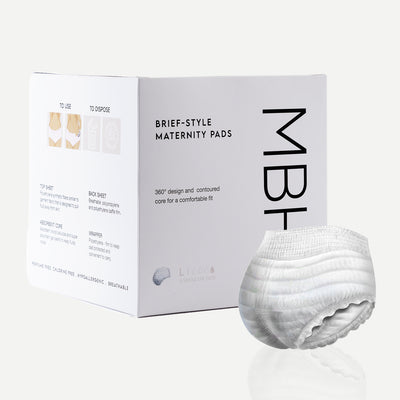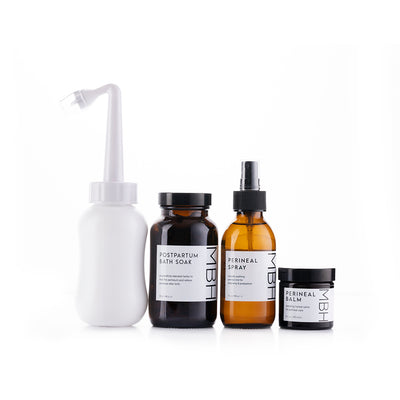Recovering from a C-Section Delivery
It takes longer to recover from a caesarean birth than it does a vaginal delivery – usually around six weeks in total – so despite having a newborn to look after you do still need to make sure you have plenty of rest, and that you really take care of your post-op body.
WOUND CARE
Your health visitor should advise you on how to look after your wound. You'll usually be advised to:
Gently clean and dry the wound every day.
Wear loose, comfortable clothes, and cotton underwear.
Take painkillers for as long as you need them if you are feeling any discomfort. Paracetamol is usually recommended for mild pain, co-codamol for moderate pain, and a combination of co-codamol and ibuprofen for more severe pain.
Watch out for signs of infection such as extra soreness, redness, or discharge, or if the wound feels hot to the touch. Tell your health visitor if you spot these signs, if you feel feverish, or if it looks like the wound is coming apart.
Non-dissolvable stitches or staples will usually be taken out by your midwife after five to seven days. After about six weeks, your scar will be healed and you'll likely be able to resume all regular activity without disturbing it. Giving yourself at least six weeks of healing time allows the incision lines to mature so that when strenuous activities are performed, the integrity is not compromised.
SCAR MANAGEMENT
Scar management helps to create the best possible healing of a scar. You can start to do scar tissue mobilization around 12 weeks after your c-section or earlier IF you are given the green light by your GP or health visitor. This can help to reduce infection and aid in skin and tissue motion.
To perform scar tissue mobilization,
Pinch the surrounding skin and surgical scar in your fingers rolling it in different directions. Up/down. Left/right. Right diagonal /Left Diagonal. You can also "twist" stubborn areas to get them moving.
Use your three middle fingers and place them over the scar. Rotate them clockwise and counterclockwise. Look for which directions cause movement restrictions when areas are stubborn. Once you find the restriction keep your fingers holding it and take 3 deep breaths.
Desensitization Techniques:
Besides scar tissue management one thing that you can start right away is desensitizing the area. Often women experience sensitive skin in the surgical area. This is because they cut through your tissue and your cutaneous nerves. Cutaneous nerves are peripheral nerves that give your skin sensation. They can regrow and there are ways to help them regrow and also become less sensitive. Try desensitizing on a daily basis starting a week after your C-section. 3-5 times per day is best but something is better than nothing.
Prior to your c-section, you can create a nerve desensitization kit. This is basically a kit with materials with different textures. At first, you can use soft materials like a fuzzy cotton ball or a piece of silk. Later, you can use rougher textures such as towels, paper towels, felt, soft velcro, corduroy, and sandpaper. Rub the C-section incision area with the material for 5-10 minutes at a time. At first, it will feel a bit weird because you are actually slightly irritating the nerve to encourage it to heal faster.
PHYSICAL RECOVERY
Wear loose fitting clothing and underwear – You’ll want to avoid putting too much pressure on your healing scar.
Take things slowly - You might find your tummy feels quite sore doing mundane things like walking up and downstairs, and getting in and out of a chair or bed – so take things gently and slowly. Keep everything you need, like diaper changing supplies and food, close to you so that you don’t have to get up too often. Don’t lift anything heavier than your baby. Whenever you have to sneeze or cough, hold your abdomen to protect the incision site. Avoid low chairs and really deep chairs/couches. If you have a deep couch at home place pillows behind you so that you don't have that far to go backwards while sitting.
Eat fibre-rich food – Eating food rich in fibre will help to avoid constipation and keep everything moving. Make sure that also drink plenty of fluids as this will help prevent constipation
You'll need to use maternity pads after your caesarean, because you will have some bleeding from your womb (lochia) just as you would after a vaginal birth, although the blood loss may be lighter.
If your caesarean was an emergency, your medical team may first have tried to help your baby be born with ventouse or forceps. If so, you're likely to have a sore area between your vagina and back passage (perineum) especially if you've had stitches. You can follow our tips for perineum care.
Most importantly get plenty of rest and allow yourself time to heal! It is normal for to want to jump right back into your routine after your baby is born, but will need to slow down. It is important to remember that you just experienced major surgery. Transitioning to life with a baby after a C-section is hard but allow yourself time to rest will allow your body the best opportunity to heal.
EMOTIONAL RECOVERY
While physical recovery from a C-section is usually straightforward, how you will recovery emotionally will really depend on what happened before and during your baby's birth and what your birth expectations were.
It is ok to feel upset or disappointed that you didn't have a vaginal birth if that's what you were hoping for especially if you’ve had to have an emergency caesarean. If you’ve had to spend time in intensive care you may feel that you’ve missed out on those first precious moments with your newborn.
It may help your emotional recovery to talk about the reasons why your cesarean was necessary with your midwife or maternity unit counsellor which will give you the opportunity to talk through your birth experience and raise any concerns about future births.
On the other hand, you may just be glad the birth is over and grateful that you and your baby are well. Many mums recover quickly and accept their caesarean as a part of their baby's birth story.
Helpful Products
Brief-Style Maternity Pads: These are perfect for immediately after birth. The waistband is very elastic and soft so it will not aggravate your incision site. Even with a c-section, you will still bleed for weeks on end so these will be a lifesaver as they are fuss-free, minimize mess and are very comfortable.
Abdominal Binder: Everyone should be wearing these after pregnancy. It helps reduce swelling, expels excess fluid, reduces stresses on the body, and assists your muscles/connective tissue to restore to normal as quickly as possible.
Loose clothing and C-section underwear: Try to get underwear that is high so they are comfortable on the incision and also large enough for maternity pads.
Support leggings: These sit below your bra line so you can hide your postpartum belly and make it comfortable to breastfeed and don’t dig into your incision site. The fabric is comfortable and super breathable.
Best of luck! Hope this helps in your recovery and healing!




Leave a comment